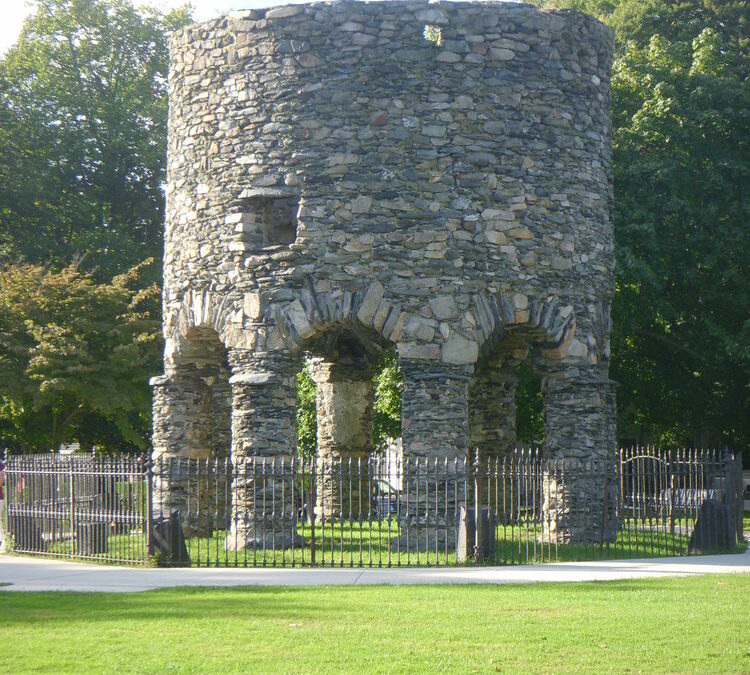Newport is home to an extraordinary number of architectural treasures. For the most part, the architects, owners, and dates of construction for these buildings are well documented. In one case, however, the dates and history of the structure are very much in contention and the alternatives stretch the imagination to its limits. The mysterious monument in Touro Park (known as Newport Tower) is a structure that dates from the earliest days of Newport’s settlement but was perhaps built even earlier.
The arched stone tower is about 23 feet in diameter and about 28 high. It is built from native rubble stones and is cemented with shell lime mortar. It was described as early as 1741 in documents as “the old stone mill” but elements of the design seem to contradict that use as there is evidence of a floor (now gone) and a fireplace and flue which still remain built into the wall above the arches. The grinding of corn and wheat creates highly flammable dust and a fireplace would be a dangerous and extremely unusual addition to such a structure.
At a recent lecture on Peter Harrison given at the Redwood Library, the architect John Grosvenor suggested that perhaps the structure was built by Peter Harrison, who is known to have designed the Redwood Library (1747) immediately to the east of Touro Park and the Touro Synagogue (1756) and Brick Market (1772) down the hill from the structure. Grosvenor postulated that perhaps the structure was built from the rubble taken from an earlier stone mill once built on the same site, potentially helping explain the confusion about the date of the construction.
But there are many other theories as well. In 1837 the Danish archaeologist Carl Christian Rafn in his book Antiquitates Americanæ proposed a Viking origin to the structure. Several authors have observed that the structure has the same characteristics as Norse structures from the thirteenth century. The Vikings conclusively made it as far as Greenland where they established settlements. The possibility of Newport having had European contact during the Pre-Columbia era, if proven, would be very exciting indeed and change the history books in terms of the settlement of North America.
Jim Egan, who moved to Newport and opened a museum on the subject of the Newport Tower in the old Red Cross building at the corner of Mill Street and Bellevue Avenue, has still a very different hypothesis about the origin of the structure. Egan has established elaborate scenarios which point to the Elizabethan mathematician, astronomer, and early colonial explorer, John Dee and proposes a date of 1583 for the structure. It is Egan’s belief that the structure was built as an early but failed attempt to establish a settlement in the location and therefore the structure was already “old” by the time of the early Newport settlement in 1639, nearly fifty years later.
Still, other authors assert that they have found sacred orientations and geometries in their study of the structure and assert that a group of Knights Templar from Scotland was drawn off course during the crusades and built the structure as a source of shelter but also a monument to their faith and the masonic codes that they believed in. An excavation done in and around the structure in 1848 and then again a century later in 1948, proved inconclusive with regard to the builders and exact dates of construction of the structure giving evidence for both a very early and then a somewhat later date of origin.
Whether a mill, a fortification, a sacred tower, or an astronomic observatory, the Newport Tower draws the minds of the Newporters and visitors alike back to times before written records were carefully kept and allow the imagination to blossom into speculation about what the tower was built for and by whom the tower was built. Whatever the answer, as we approach Easter and the vernal equinox, it is a structure worthy of protection and much further interest and study!
Looking to remodel your home? Let’s connect.
Join the Architectural Forum to stay up-to-date with architectural news from Rhode Island and abroad.
